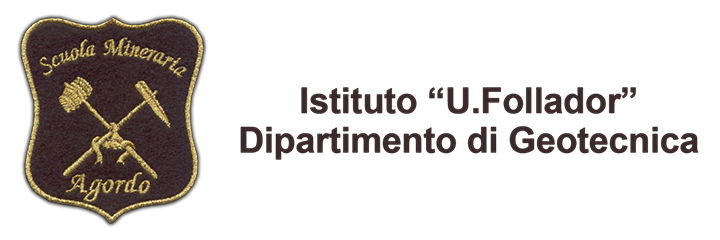Mining from its origins to the 18th century
As in almost all of the Agordino region, a fairly flourishing mining activity took place in the San Lucano valley, with dynasties such as the Crotta family and others of lesser fame as protagonists.
Because of its unique geological and geomorphological characteristics, the valley was significant in the past both from mining and mineralogical point of view; its mineralogical value is still appreciated by experts in the present. The area is affected by the contact between volcanites and sedimentary rocks: this combination gives rise to numerous collectible minerals such as heulandite, analcime, quartz, amethyst quartz, chalcedony, calcite, etc. and minerals of industrial interest such as pyrite, chalcopyrite, bornite, native copper, siderite, etc.
It was precisely the occurrence of siderite that fostered the development of the mining sector in the area.
It is believed that mining activity in the San Lucano Valley and in the Agordino goes back to antiquity, with some of the mines being already active during the time of the Romans. Such assumptions are based on historical data, such as the documented existence of an iron refining furnace which processed iron ore from Fursil and operated between 1394 and 1509 in the San Lucano valley.
The first real recorded document of such activity, however, originated from the year 1666. The Venetian-born Costa family settled in Taibon and in Forno di Val, at the mouth of the San Lucano Valley during the thirteenth century; their goal was to exploit the hydraulic energy of the Tegnas stream as well as to process the iron ore from the mines of the San Lucano Valley and its surrounding areas.
Their arrival gave rise to a flourishing iron craftwork. Not many records bear witness of the mining activity between the fourteenth and sixteenth centuries, which can likely be explained by Agordino’s troubled history during this period. The beginning of greater political stability and a major improvement of the living conditions in the Agordino during the 1600s, marked a more detailed written record on the mining concessions for prospecting in the area; the beginning of such written tradition implies a surge of mining activity in the valley of San Lucano as well.
Mining research flourished in the San Lucano Valley during the seventeenth century mainly due to two reasons: abundance of metalliferous mineralization deposits and the resulting need to satisfy the growing demands of the Republic of Venice. Because of the unclear descriptions from this time period, the exact location of the mines remains unknown: the indications cover a vast area, and in addition the sites have undergone numerous environmental and morphological changes over the centuries; last but not least, the names of the various places known to modern cartography have either disappeared or have been changed.
The locations indicating the ancient mines were positioned in part using ancient indications, reconstructed by consulting "News on the mining industry in Venice under the rule of the Republic”, by E. Oreglia (1915), and partly with the contribution of geological data retrieved nowadays - mineralised traces - which can corroborate the authenticity but can by know means give certainty.
Mining research in the twentieth century, last act
No new mining activities were recorded between 1748 and the autarchic period, when, as in the whole of the Agordino territory, searches were reopened on the once known mine sites. Many of these presumably corresponded to the old mines mentioned above. With ten concessions granted by the Republic of Venice in the seventeenth and eighteenth centuries, the San Lucano Valley represented quite the intriguing area from mining point view and attracted the attention of many entrepreneurs from Belluno.
Among these entrepreneurs stands out the name of BC di Sospirolo, who on the 12th of October 1924 filed the first application for obtaining a prospecting concession in the municipalities of Taibon and Canale d’Agordo. The application was submitted to the Prefect of Belluno, who in turn forwarded it to the Royal Mining Department (CRM) in Padua. A map indicating the area in question was enclosed with the application. Following further inquiries on behalf of the authority, a detailed report of the areas appointed for mining prospecting was issued on December 6, 1924. The report included a total of five locations: two sites in Malgonera, one in Valghere and other two in Campigat.
On the 28th of the same month B.C. submitted a new request for two further areas in Cesurette. The annual prospecting permits held by B. C. had expired in the meanwhile, and thus on the 4th of May, 1926 he submitted an application for renewal limited to the areas of Campigat 1 and 2 and Cesurette 1 and 2, while ceding those in the Malgonera area. As announced in his report from 11 January 1926, B.C. filed a prospecting request in an area which had not yet been taken into account; its presumed location is the area of the Reiane Valley. Perhaps the entrepreneur associated the area with the old iron mines of the Crotta family and was intent on exploiting not only the copper but also the iron ores. The prospecting permit in the Campigat area was sold to the L.S. & C company on the 14th of June 1926. The latest record of a granted prospecting permit for the area dates back to the year 1929.
This is how the mining industry in the San Lucano ebbed away - almost as a footnote to its rich history as Nature took over the areas where man has toiled for many centuries. Nowadays the real mine is the entire valley with its uniqueness from geological and landscape perspective. Its stunning beauty represents a secure investment as tourist destination for the inhabitants.







